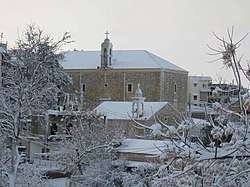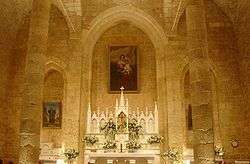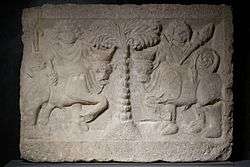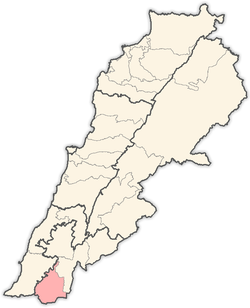Ain Ebel
ʿAin Ebel (Arabic: عين إبل; Syriac: ܥܝܢ ܐܒܠ), the ancient 'En Bol,[1] is a village located in the Lebanese Upper Galilee[2] in the Caza of Bint Jbeil in the Nabatiye Governorate in Lebanon.
ʿAin Ebel عين إبل – ܥܝܢ ܐܒܠ | |
|---|---|
City | |
 ʿAin Ebel Location within Lebanon | |
| Coordinates: 33°07′N 35°24′E | |
| Grid position | 187/279 PAL |
| Country | |
| Governorate | Nabatieh Governorate |
| District | Bint Jbeil District |
| Government | |
| • Type | 15 Member Municipal Council |
| • Body | Municipal Council |
| • Mayor | Imad Lallous |
| Highest elevation | 850 m (2,790 ft) |
| Lowest elevation | 750 m (2,460 ft) |
| Time zone | UTC+2 (EET) |
| • Summer (DST) | UTC+3 (EEST) |
| Dialing code | +961 |
Etymology
Historian Taissier Khalaf writes that the name of the town means "Spring of the Monk" because in Aramaic Ain means spring and Ebel means the hermit, who wears a monk's garb.[3] While Anis Freiha and Friar Youakim Moubarak believe that Ebel is a corruption of the word Baal, in reference to the Semitic god associated with storms and thus irrigation,[4] and combined with Ain then the name may mean the "Spring of Irrigation".[5] Edward Henry Palmer, in 1881, wrote that it meant "The Spring of Camels" taking a literal translation for the name from classical Arabic.[6]
Variation of Spelling
The name of the village is also sometimes spelled Ainebel, Aïn Ebel, Ain Ebl, ‘Ayn Ibil, ‘Ain Ibil, Aïn Ibel, Ain Ibel.
History
Ain Ebel is a historic village with numerous archaeological sites.
Prehistory
Lower Paleolithic implements were found in Ain Ebel, and historian believe that prehistoric man lived and hunted in the area from the most ancient times[7]. A Heavy Neolithic site of the Qaraoun culture was discovered by Henri Fleisch west of Ain Ebel in the Wadi Koura, with tools found suggested to be part of a forest dweller's toolkit at the start of the Neolithic Revolution.[8] The region stretching from the north of Ain Ebel to south near Yaroun is rich in flint instruments, and the whole surrounding region as far as Jish contains megalithic ruins, perhaps pre-Canaanites[9].
Ancient History
In the Babylonian Talmud, Ain Ebel is referred to as 'En Bol, and identified as a village northwest of Safed, where minorities practiced a form of niddah in which female infants were made to undergo the ritual immersion before their mothers. [1]
Historian John T. Durward argues that Ain Ebel, located west of Kedesh of Naphtali (an ancient town documented in Judges 4:6, 10), is probably the biblical town of Beth Maacah, and was the spiritual retreat of the clergy from Tyre and Acre.[10]
On the outskirts of the village is an area called Chalaboune where Ernest Renan, a French historian and philosopher who was sent by Emperor Napoleon III to Lebanon, found ancient graves.[11] According to Renan, Ain-Ebel had beautiful underground passages and large buildings in colossal stones and admirable carved sarcophagi in two remarkable places, Douair and Chalaboune, which he believed was the Biblical town of Shaalabbin of the Tribe of Dan[12]. On one of the graves, Renan discovered a bas-relief of Apollo and Artemis. The relief was transported to France where it remains today at the Louvre.[13] In 2011 and after months of negotiation, the Musée du Louvre agreed to make an exact replica of the bas-relief, which was delivered to the municipality of Ain Ebel in November.[14]
Modern History
It is believed that the village has been continuously inhabited at least since the 15th century when Christians from the north of Lebanon migrated to lower elevations in the south to cultivate feudal lands.[15]
In his book, Salut Jerusalem: Les memoires d'un chretien de Tyr a l'epoque des Croisades, the Lebanese historian, Bechara Menassa, wrote that the people of Ain Ebel were in touch with the Crusaders in Toron, modern Tebnine. Menassa described how a Frankish monk killed a wild animal in Ain Ebel.
Late Modern Period
In January 1837, Ain Ebel was hit by the Galilee earthquake, which devastated the South all the way to Safad and Tiberias.[16]
By the mid-nineteenth century, Ain Ebel had become the principal village of Christianity in the Upper Galilee, and in 1861 it was chosen for the first religious retreat organized in the Holy Land where 55 priests from the archdioceses of Tyre and Acre gathered for a reunion[17].
Ain Ebel is mentioned in a Christian anthology, containing contributions from ministers and members of various evangelical denominations published in the United Kingdom in 1866:
Forwards we marched, with light spirits, through close woods, varied by occasional clearings, like what are called the 'rides' in old English forests; and sometimes we arrived at snug villages or prospects of such by the names of Teereh, Hhaneen and Ain Ibil, the latter at two hours from Tibneen. The people are Christians, and they cultivate silk and tobacco... A poor Maronite priest in his black robes and dark blue turban, came up to me, and, leaning on his staff, represented the sad story of his village (Ain Nebel) the day before, when of the subordinate officers of Tamar Bek, going round to inspect the Christians in their compulsory and unpaid labour at the lime-kilns, and finding the work of one of the men not equal to the task exacted, shot him dead on the spot.
— Johnstone, John, "Byeways in Palestine by a British Consul, Upper Galilee, Forest Scenery", page 188, The Christian Treasury, Volume 22 (1866)
In 1875 Victor Guérin visited, and noted 800 Maronite and 200 Greek Orthodox villagers.[18]
In 1881, the PEF's Survey of Western Palestine (SWP) described 'Ain Ibl as a: "Well-built modern village, with a Christian chapel ; contains about 1,000 Christians (800 Maronites and 200 United Greeks). It has vineyards on the slope of the hill on which the village is placed, and olives in the valley below. Good water supply from springs in the valley."[19]
P. Engbert writes that the inhabitants of Ain Ebel offered the Jesuits in 1888 a fairly large lot of land after almost all the inhabitants signed the petition which was presented to R. P. Lefebvre.[20]
In 1889, the village harvest was bad and an epidemic spread among the townspeople, lasting all winter and killing more than fifty people.[21]
French Mandate
By 1920, Ain Ebel had a population of 1,500, living in about 300 houses.[22] That year, while delegates from The Shia Conference of El-Hujair were in Damascus swearing allegiance to King Faisal, an act the Maronites of Jabal Amel considered threatening, Mahmoud Bazzi's gang, which "proceeded from brigandage to confronting France and its Christian friends in the south,"[23] attacked Ain Ebel on May 5, 1920, pillaging and killing more than 50 people.[24][25] The people of Ain Ebel defended the town from sunrise to sunset until they ran out of ammunition[26] The town was completely destroyed, and the damage done to the two churches, school and convent, were evidence of sectarian malice.[22][27] The neighboring villages of Debel and Rmaich were also attacked so after 12 days of plundering and massacres[28], the French arrived and suppressed all activities in Jabal Amel region[29] The massacres hardened Maronite opinion in favor of Jabal Amel being part of Greater Lebanon, which borders were cemented at the San Remo conference in 1920.[23]
During the French Mandate, the network of paved road expanded, coinciding with the introduction of automobiles in Lebanon. The arrival of the first car in a village became a celebratory event, and this was true in Ain Ebel, where the inhabitants, dressed in their Sunday best, gathered in the church square to welcome the first car to drive through the village.[30] The French planned to build an automobile road to connect the southern villages with those of Mandatory Palestine. The original plan was to build the road from Bint Jbeil via Yaroun and Rmaich, but the people of Ain Ebel protested, knowing the significance of such a road for the development of their town, and in the end, they were able to convince the French government to change the plan and have the road run through the village.[31]
Contemporary History
During World War II, the Vichy French had a line of widely spaced blockhouses that stretched from the coast to the inland heights, reaching Ain Ebel.[32] During the Syria–Lebanon Campaign to liberate Lebanon and Syria from the Vichy, Australian Captain Douglas George Horley was ordered to clear Ain Ebel[33]. Australian Brigadier J. E. S. Stevens decided that he would seize Aitaroun, Bint Jbel, Ain Ebel, Yaroun, Rmaich, Ayta ash Shab, Ramié, Jereine, Aalma ech Chaab and Labouna to cut a road from Al-Malkiyya to the French frontier road so as to make a second gateway into the coastal zone[34]. The Australian squad, guided by Meir Davidson's squad, finally captured the town of Bint Jbeil and the villages of Aitaroun and Ain Ebel[35]. After taking Yaroun and Bint Jbeil, Ain Ebel was found to have been abandoned by the Vichy[36].
In the late 1960s and early 1970s, the village was often caught in the skirmishes between the Palestine Liberation Organization and the Israel Defense Force.[37]The Palestine Liberation Organization imposed a food and fuel blockade on Christian villages, such as Ain Ebel and Qlaiaa, forcing the inhabitants to deal with Israel.[38]. Christian militia arrived in Ain Ebel and neighboring Christian villages in August 1976[39] to open a new line of confrontation against the PLO strongholds in neighboring villages, thus jeopardizing the very good relationships that Ain Ebel had with its Muslim neighbors[40].
In July 2006, Ain Ebel, like other villages that string Lebanon's southern border, such as Debel, Qaouzah, Rmaich, and Yaroun, was caught in the 2006 Lebanon War between Hezbollah and the Israeli army.[41] The village and its surrounding valleys were used as a military area by Hezbollah.[42] During the conflict, the village witnessed ferocious battles with missiles destroying many houses and orchards and leaving the townspeople besieged and without bread for three weeks.[43] After allegations that Hezbollah was using humans as shields, the Human Rights Watch visited Ain Ebel on several occasions, and their "investigations revealed that Hezbollah violated the prohibition against unnecessary endangering civilians" when they launched rockets from or near civilian homes, adding that on July 24, around 9:30 am, a convoy of 17 vehicles, fleeing Ain Ebel also came under Israeli fire, putting civilians under risk and preventing them from leaving the village.[44][45]
Geography
Located in the mountainous region of southern Lebanon, known as Belad Bechara[46] in Jabal Amel, or the Lebanese Upper Galilee, Ain Ebel occupies several hills with elevation ranging from 750 to 850 meters above sea level. There are three natural springs in Ain Ebel, including Tarabnine, Tahta and Hourrié, and in the valley between Ain Ebel and Hanine is Ain Hanine.[47].

Climate
The village enjoys four seasons with autumn and spring being mild but rainy, winter being cold and sometimes snowy and summer being dry and very pleasant with average temperatures between 25–27 °C (77–81 °F).
Demographics
The people of Ain Ebel are mainly Maronite Catholics, Greek Catholics and Armenian Catholics.[51]
Families
- Atmé
- Alam
- Akh
- Abu Ghannam
- Ajaka
- Amouri
- Ammar
- Andraos
- Ayoub
- Ghostine (also Lubbos and Lopes in Brazil)
- Barakat
- Bechara
- Berberian
- Chaaya (also spelled Shaaya)
- Chbat (also spelled Chebat)
- Chehadé
- Dally
- Diab (Diap and Diep in Argentina)
- Dick (also spelled Deek)
- Eid
- Farah
- Haddad
- Hasrouny (also spelled Hasrouni)
- Jichy (also spelled Jichi)
- Karam
- Khalifé
- Khoreich (also spelled Khreiche, Khraish in the US and Canada and Kreis in Argentina)
- Lallous
- Matar
- Najm (also spelled Najem)
- Sader
- Sakr (also spelled Saqr or Sacre)
- Sidaoui
- Zarqa
Education
There are three schools in the village: two private schools (Saints-Cœurs and Saint Joseph) and one public school. Of the three, the oldest is Saints-Cœurs, which was established by the Jesuits in 1881.[52]
Within a decade, Ain Ebel had two schools, and Missionary Père Angelil requested the aid of the nuns of Ain Ebel in 1890 to teach for eight days the inhabitants in neighboring Mi'ilya after which two nuns remained there to manage the new school.[53]
Arts & Culture
Architecture
There are three historic churches, built in the eighteenth and nineteenth century, and a convent that was built in 1857.[54]
Religious Structures

Chapels
- Chapel of the Sacred Heart
- Saint Mary's Chapel
Churches
- Our Lady of Ain Ebel Maronite Catholic Church
- Saint Elie Greek Catholic Melkite Church
- The New Saint Elie Greek Catholic Melkite Church
Convents
- Convent of the Sacred Heart
Shrines
- Saint Charbel Shrine
- Our Lady of Lourdes Monument
Festivals
Each summer, a grand festival is organized in honor of the Blessed Virgin Mary. The festival culminates on the Assumption of Mary on August 15. Outdoor events and open-air concerts are held in the village's square. The festivities peak with a procession of the Virgin Mary icon.
Notables from Ain Ebel
Academia
- Dr. Hiam Sakr, the President of the American University of Science and Technology
Arts
- Francois Diab, author of Le Mirage humain[55]
- Wadih Chbat, author of Constitution of Lebanon: History, Text, Amendments [56]
- George Diab, actor
- Raimundo Fagner, singer
- Karol Sakr, singer
- Pascale Sakr, singer
- Raja Haddad, singer
Clergy
- Monsignor Elie Barakat
- Monsignor Elias Farah
- Clementine Khayat, a Catholic nun from Ain Ebel who wrote several articles in the journals, El-Mashriq and El-Bashir recounting the events of the massacre of May 5, 1920 that she witnessed.[57]
- Monsignor Albert Khoraich
- Anthony Peter Khoraich, the late Cardinal, is the most prominent modern figure from Ain Ebel. He was the second Lebanese Patriarch to become cardinal of the Catholic Church.
- Bishop Maroun Sader
- Archimandrite Boulos Samaha
Journalism
- Jean Diab, who wrote for the Revue du Liban
- Wafai Diab, who was believed to be the first Arabic-language journalist to interview an American President at the White House.
- Nasrat Khoreich, who wrote for both Annahar and L'Orient Le Jour
In Literature
- In Half a Lira's Worth: The Life and Times of Vivronia by Mick Darcy
- "The Kazzy family, in the early 1920s, were small landholders in the village of Ain Ebel, in Southern Lebanon...
Gallery
 Ain Ebel at sunset in the summer
Ain Ebel at sunset in the summer
References
- Translated by Rabbi Dr. I Epstein B.A., Ph.D., D. Lit (1935). The Talmud Babylonian: Seder Tomoroth, "Tractate Niddah," Folio 32a. Halakah. Retrieved 3 May 2019.CS1 maint: multiple names: authors list (link)
- Piveteau, Jean. La Préhistoire: Problèmes Et Tendances, Ed. du Centre national de la recherche scientifique, Paris, 1968, Page 113
- Khalaf, Taissier (2006). al-Masīḥ fī al-Jūlān : Tārīkh wa-Athār (Christ in the Golan: History and Traces) (in Arabic). Dār Kanʻān
- Freedman, David Noel, ed. (1992), The Anchor Yale Bible Dictionary, Vol. 1, New York: Doubleday
- "Archived copy". Archived from the original on 2003-12-02. Retrieved 2008-10-13.CS1 maint: archived copy as title (link)
- From A Personal name, according to Palmer, 1881, p. 62
- Field, Henry. Ancient and Modern Man in Southwestern Asia, Volume 1, University of Miami Press, 1956, page 44
- L. Copeland; P. Wescombe (1966). Inventory of Stone-Age Sites in Lebanon: North, South and East-Central Lebanon, p. 88. Impr. Catholique. Retrieved 3 March 2011.
- Hulot & Rabot, "Actes de la societé géographie," Seance du 6 décembre 1907, La Géographie, Volume 17, Paris, 1908, page 78
- Durward, John T. Holy Land and Holy Writ, The Pilgrimage Publishing Company, Baraboo, WI, 1913, page 668
- Renan, 1864, pp. 677-8
- Minervini, Giulio. Bulletino archeologico italiano, Volumes 1–2, "Antichità Oritentali", Naples, Italy, 1862 pages 150–151
- Conder, C.R.; Kitchener, H.H. (1881). The Survey of Western Palestine: Memoirs of the Topography, Orography, Hydrography, and Archaeology 1. London: Committee of the Palestine Exploration Fund., page 236
- Al-Amin, Danny. "عين ابل تفاوض اللوفر وتستعيد نسخة عن تحفتها", Al-Akhbar, Issue 1565, 18 November 2011
- Jalabert, Henri and Joseph Goudard. Lebanon, the Land and the Lady, First Edition, Translated to English by Eugene P. Burns, SJ. Catholic Press, Beirut, January 1, 1966, page 24
- Khalaf, Samir. Protestant Missionaries in the Levant: Ungodly Puritans, 1820–1860, Routledge; 1 edition (July 24, 2012), page 211
- Ramière, du R. P. H. Le Messager du Sacré-Cœur de Jésus, Croire aujourd'hui, "La Première Retraite Ecclésiastique En Terre Sainte," par Fenech, Aloisius, Sidon, 29 June 1861, Paris, Maison Périsse, Régis Ruffet Success, 1863, page 211
- Guérin, 1880, pp. 120-121
- Conder and Kitchener, 1881, SWP I, p. 200
- Relations D'Orient. "Missions Dans La Haute-Galilée" par P. Engbert, 22 August, 1988, Imprimerie Polleunis, Ceuterick et de Smet, Brussels, 1889, page 28
- Relations d'Orient: Liban, Syrie, Egypte, Arménie, "Travaux et Missions Dans Le Belad-Bechara et le District de Saphad: Extrait de Lettres du P. Angelil au P. Supérieur de la Mission," Imprimerie Polleunis et Ceuterick, Bruxelles, Janvier 1891, page 35
- The New Near East, Volumes 6–8. The Near East Relief, New York, NY, June 1921, page 12
- Harris, William H. Lebanon: A History, 600 – 2011, Oxford University Press, 2012, page 177
- Chalabi, Tamara. The Shi'is of Jabal 'Amin and the New Lebanon: Community and Nation-State, 1918–1943. Palgrave Macmillan, New York 2006, page 79
- Gharbieh, Hussein. Lebanese Confessionalism and the Creation of the Shiʻi Identity, Dar El-Manhal El-Lubnani, Lebanon, 2010, page 59, 63
- The New Near East, Volumes 6–8. The Near East Relief, New York, NY, June 1921, page 12.
- The Times History of the War, Volume 21, The New York Times, 1920, page 449
- Villeneuve de, Armand, Catholic Missions: Annals of the Propagation of the Faith, Volume 1, "A Poor Mission of Syria," Society of the Propagation of the Faith, NY, MY 1924, page 91.
- Gharbieh, Hussein. Lebanese Confessionalism and the Creation of the Shiʻi Identity, Dar El-Manhal El-Lubnani, Lebanon, 2010, page 60.
- Schayegh, Cyrus and Andrew Arsan (Editors), The Routledge Handbook of the History of the Middle East Mandates, "Sanctity Across the Border: Pilgrimage Routes and State Control in Mandate Lebanon and Palestine" by Toufoul Abou Houdeib, Routledge Taylor & Francis, New York, 2015, page 387
- Ajaka, Elias. From the Caches of Memory, Dar Alfarabi, Beirut, 2015
- Long, Gavin. Australia in the War of 1939–1945: Greece, Crete and Syria, Australian War Memorial (1953),page 342
- Long, Gavin. Australia in the War of 1939–1945: Greece, Crete and Syria, Australian War Memorial (1953),page 349
- Long Gavin, Australia in the War of 1939–1945, Series One: "Army", Volume 2: "Greece, Crete and Syria", Chapter 16: "The Syrian Plan", Australian War Memorial, Canberra, 1953, page 342
- Bauer, Yehuda. From Diplomacy to Resistance, "Difficulties of the First Year", Varda Books, Skokie, Illinois, 2001, page 159
- Long Gavin, Australia in the War of 1939–1945, Series One: "Army", Volume 2: "Greece, Crete and Syria", Chapter 16: "The Syrian Plan", Australian War Memorial, Canberra, 1953, page 349
- Totten, Michael J. The Road to Fatima Gate: The Beirut Spring, the Rise of Hezbollah, and the Iranian War Against Israel, Encounter Books, New York, 2011, page 187
- Sayigh, Yezid. Armed Struggle and the Search for State: The Palestinian National Movement, Oxford University Press, 1997, pages 410-411
- Bannerman, Graeme M. Lebanon in Crisis: Participants and Issues, Syracuse University Press, 1979, page 48
- Meier, Daniel. Shaping Lebanon's Borderlands: Armed Resistance and International Intervention in South Lebanon, Library of Modern Middle East Studies, I.B. Tauris; Sew edition (September 28, 2016)
- USATODAY.com – Archbishop tells church to stay in Lebanon: 'You'll make it'
- Totten, Michael J. The Road to Fatima Gate: The Beirut Spring, the Rise of Hezbollah, and the Iranian War Against Israel, Encounter Books, New York, 2011, page 195
- Tavernise, Sabrina (2006-08-02). ""Hilltop Village in Lebanon Feels Stuck in the Middle"". The New York Times.
- Bouckaer, Peter. Why They Died: Civilian Casualties in Lebanon During the 2006 War, Volume 19. The Human Rights Watch, pages 54–55
- Bouckaert, Peter. Fatal Strikes: Israel's Indiscriminate Attacks Against Civilians in Lebanon, Volume 18, The Human Rights Watch, page 15
- Ledochowski, Wladmir. Lettres de Jersey, Volume 2, "II-Au Belad-Bechara," Jules de Meester & Fils, 25 December 1924, page 391
- Hulot & Rabot, "Actes de la societé géographie," Seance du 6 décembre 1907, La Géographie, Volume 17, Paris, 1908, page 78
- Ozmun, Edward, H. "Bitumen Mining Industry of Turkey", The Mining World, Mining and Engineering World, Volume 8, page 910, June 6, 1908
- Abraham, Herbert. Asphalts and allied Substances: Their Occurrence, Models of Production, Uses in the Arts and Methods of Testing, Springer Science & Business Media, New York, 1938, page 157
- Hulot & Rabot, "Actes de la societé géographie," Seance du 6 décembre 1907, La Géographie, Volume 17, Paris, 1908, page 78
- Santoro, Nicholas Joseph. Mary in Our Life: Atlas of the Names and Titles of Mary, the Mother of Jesus, , Bloomington, (August 5, 2011)page 150
- Abu Saibi, Saif Najah, Jabal Am3l in the Ottoman Era: 1882 – 1914, Historical – Intellectual Study, Opus Publishers, Ontario, Canada, 2017, page 226
- Relations d'Orient: Liban, Syrie, Egypte, Arménie, "Travaux et Missions Dans Le Belad-Bechara et le District de Saphad: Extrait de Lettres du P. Angelil au P. Supérieur de la Mission," Imprimerie Polleunis et Ceuterick, Bruxelles, Janvier 1891, page 37-38
- Abu Saibi, Saif Najah, Jabal Am3l in the Ottoman Era: 1882 – 1914,Q Historical – Intellectual Study, Opus Publishers, Ontario, Canada, 2017, page 227
- Le Mirage humain, Poètes du temps présent, ISSN 0337-1131. Publisher. La Pensée universelle, 1985
- Constitution of Lebanon: History, Text, Amendments, DDC Classification: 342.56202. Publisher: Beit-el-Hikmah, Beirut, 1968
- Chalabi, Tamara. The Shi'is of Jabal 'Amin and the New Lebanon: Community and Nation-State, 1918–1943. Palgrave Macmillan, New York 2006, page 79-80
Bibliography
- Conder, C.R.; Kitchener, H.H. (1881). The Survey of Western Palestine: Memoirs of the Topography, Orography, Hydrography, and Archaeology. 1. London: Committee of the Palestine Exploration Fund.
- Guérin, V. (1880). Description Géographique Historique et Archéologique de la Palestine (in French). 3: Galilee, pt. 2. Paris: L'Imprimerie Nationale.
- Palmer, E.H. (1881). The Survey of Western Palestine: Arabic and English Name Lists Collected During the Survey by Lieutenants Conder and Kitchener, R. E. Transliterated and Explained by E.H. Palmer. Committee of the Palestine Exploration Fund.
- Renan, E. (1864). Mission de Phénicie (in French). Paris: Imprimerie impériale.
External links
- https://web.archive.org/web/19990117073503/http://ain-ebel.org/
- https://web.archive.org/web/20090422040334/http://www.khoreich.com/
- https://web.archive.org/web/20061010121040/http://www.ain-ebel.ca/
- https://web.archive.org/web/20071001005424/http://www.fallingrain.com/world/LE/2/Ayn_Ibil.html
- The siege of Ain Ebel
- http://www.ourladyofainebel.org
- Ain Ebel, Localiban
- Survey of Western Palestine, Map 4: IAA, Wikimedia commons

